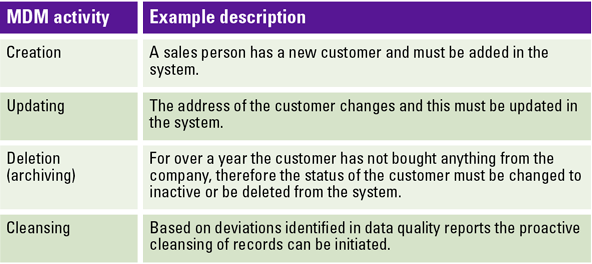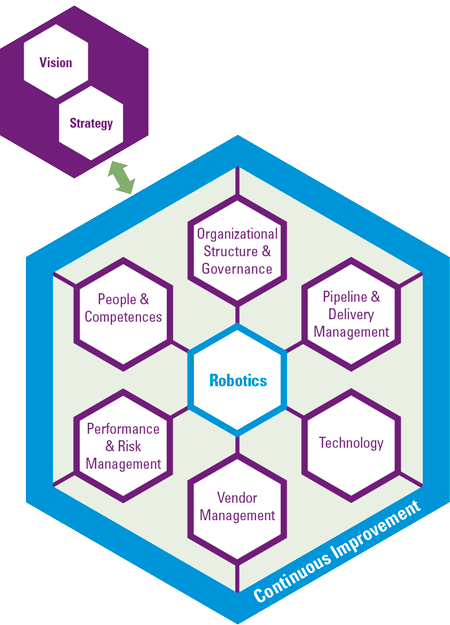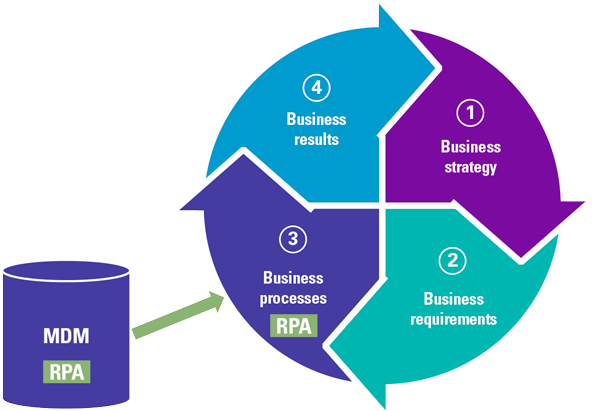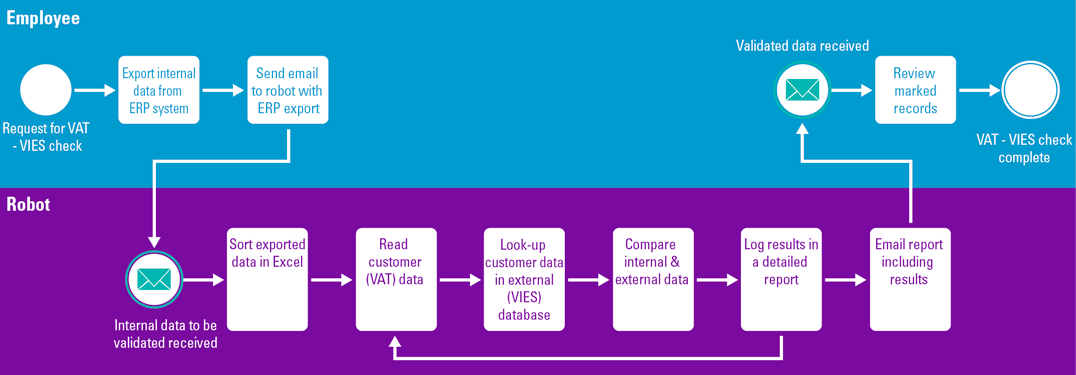This article elaborates on the possibilities to digitize and automate time-consuming master data management activities via the use of Robotic Process Automation (RPA). It will touch upon each of the concepts individually and how they can be combined to create an efficient future-proof master data management department. In addition, the article contains various appealing use cases of how RPA can be embedded in current master data management activities.
Introduction
Organizations often face manual activities that need to be performed within the area of Master Data Management (MDM). During the last years the maturation of technologies such as Robotic Process Automation (RPA) has enabled organizations to increasingly standardize, automate and improve efficiency within their processes by reducing manual labor and being the first time right. This article will provide insight into how MDM can be enhanced through the application of RPA. First, the concepts of MDM and RPA will be briefly introduced. Then, the benefits and use cases of integrating RPA in MDM will be highlighted, showing opportunities to capture value from this combination.
Master Data Management
Master data management concerns itself with the control of an organization’s most critical and core data that describes objects and assets, such as customers, employees, or products. Complete and accurate master data contributes to better decision making, less cost, less re-work, higher process efficiency and complying to regulations ([Staa13]). To gain these benefits from MDM, KPMG has developed an approach which is organized into four building blocks; governance, processes, content & quality and systems & tooling. While growing your organization’s capabilities in these four building blocks, of which each will contribute to improved MDM, the focus in this article will lie on the processes that have potential for automation. Operational processes within MDM are primarily concerned with supporting the daily operations of business processes. Many opportunities exist in the maintenance of master data by means of creation, updating, deletion (archiving) or cleansing.
Table 1. Four examples of Master data management activities which are performed on a regular basis. [Klik op de afbeelding voor een grotere afbeelding]
Examples of departments that routinely need to keep their constantly changing data assets up to date include marketing, sales and customer service. This is also important for product management and R&D, who work closely together with sourcing and operations to make sure materials can be purchased from suppliers and manufactured into new product offerings.
Understanding how your master data is supporting your business processes is a prerequisite for knowing if, and how, automation of master data operations can be leveraged into efficiency gains. Moreover, the number of changes and risk of errors in MDM processes must be considered as well, since not all master data operations are the right candidate for automation. Evaluating these factors thoroughly is key for an optimal investment in automation.
The rise of Robotic Process Automation
As mentioned in the introduction, the maturity of Robotic Process Automation has encouraged many organizations to start with the implementation of RPA within their business departments, such as in Finance, HR or IT. RPA is a low-code (business) solution that enables software robots to automate processes previously performed by humans. To successfully implement RPA, it is important to focus on manual and repetitive activities that follow clear-cut rules and make use of structured data. The software robot uses the user interface of existing applications and includes techniques such as screen scraping, rules engines and workflows. When processes involve more complex logic or unstructured data, intelligent automation (advanced RPA) can be a solution. By embedding smart add-ons, such as machine learning, chatbots, and algorithms, the scope of business processes eligible for automation increases.
One of the main advantages of using RPA is that the implementation time is relatively short. In addition, RPA is less expensive than human labor, an RPA software license is available for a fraction of FTE related costs and can perform the work of 3-4 FTE. The development of a software robot within a standard business process can be finalized in a couple of weeks, resulting in a quick return on investment. Typically, RPA is implemented through a Center of Excellence (CoE) consisting of both business and IT involvement within the business itself and is closely aligned with the process specialist. In comparison to more comprehensive IT implementation projects, this approach results in more business focused, tailor made solutions with attention to the details. Next to a quick return on investment and less implementation time, RPA has multiple other benefits that are also relevant for MDM – which will be discussed later.
Considerations for a successful RPA implementation
Organizations that have started RPA through proof of concepts and move forward with an increasing amount of software robots, usually experience that it is important to start thinking about RPA-specific governance and the impact of automation on their organization. A solution to govern software robots in a controlled manner is to design and implement the target operating model for RPA. KPMG developed an RPA implementation model (the so-called 6×6 model) that covers all organizational aspects that should be considered when implementing RPA on a larger scale. This model (Figure 1) helps companies implement RPA in a sustainable manner. Part of the framework are the RPA vision (e.g. organizational vision, business drivers) and RPA strategy (e.g. sourcing strategy) which continuously drive evaluation of the levers. These levers act as a framework to help design the proper implementation approach and operating model, safeguarding an effective implementation of RPA within your organization ([Jutt18]).
Figure 1. KPMG’s 6×6 RPA implementation framework. [Klik op de afbeelding voor een grotere afbeelding]
The application and integration of RPA in MDM
For several years, RPA has been successfully applied throughout the Finance domain, typically within the standard Purchase-to-Pay, Record-to-Report and Order-to-Cash business processes. For example, a large corporate client has implemented RPA to enter invoice details into the ERP system, post manual journal entries and prepare financial reports by using multiple software applications. After the successful introduction of RPA within Finance, other business areas quickly followed such as HR, IT, Procurement, Tax and Internal Audit. Currently, organizations with MDM functions are exploring how to start using RPA within MDM processes.
Figure 2. A simple model for how business results within organizations are realized, with a focus on how MDM acts as an important enabler for relevant business processes. [Klik op de afbeelding voor een grotere afbeelding]
To gather ideas for process improvements, companies have different approaches how to find the best opportunities for RPA and intelligent automation. One interesting and effective way is to use Process Mining to identify opportunities for RPA. By using this technology, business analysts can identify MDM focus areas and input for business cases. Process Mining helps in finding disruptions within a business process caused by master data issues, activities that are performed by humans that take too much time and deviations from the standard business process ([Rame16]).
In order to determine if a business activity is suitable for RPA, it is important to consider whether it is a standard business process. As a rough guideline, the more mature a process – in terms of standardized delivery – the more eligible it is for process automation. However, some operations require human intervention due to complexity or compliance constraints. Important considerations related to the required level of expertise, necessity of speed, and sensitivity of the data, need to be considered for optimization through reconfiguring the service delivery model ([Staa17]). For these type of processes – where it is more difficult to apply a rule-based RPA solution – organizations can include more intelligent techniques (e.g. machine learning and algorithms) in the intended automation of these business processes.
Other operations can be neatly automated by systems natively managing processes and handoffs with other systems, such as interfaces pulling data from APIs, and many software providers support in this area. However, even though the promise of a more integrated IT landscape has always been lurking, in practice businesses are dealing with legacy systems still performing critical functions, uncoordinated approaches and silo solutions, and the use of slow and manual human interventions to make all this work together. The tradeoff between system integration through interface and the use of RPA is often a strategical decision related to costs. Considering the relatively lower costs, RPA allows companies to automate the manual workarounds that exists, and in this way, promotes more consistent master data operations and output within the organization.
Examples of use cases
Various use cases can be identified of how RPA in MDM can be used to drive down operating costs and can contribute to improved master data quality (e.g. data maintenance, data quality monitoring, and cleansing). Take data quality monitoring and cleansing, which, if done correctly, should already be performed based upon pre-set business rules which determine the erroneous records to be corrected. While relatively simple checks would be automatically performed in databases, more complex business rule validations can include cross validations with reference data residing in different systems. Reference data are data that define the set of permissible values to be used by other data fields. Options are copying the reference data to the source system to run a simple, internal check, or looking up the data in the secondary internal or external database. Using RPA, any lookup of reference data can be made feasible, underlining the use of existing and high-quality sources to run your business processes, meanwhile saving a lot of time. In some instances, auto correction of faulty input at the intake part of the process can work too, preventing even the entry of bad quality data rather than fixing it.
Benefits of the application and integration of RPA in MDM
The benefits for master data management and Robotic Process Automation are clear and can be grouped as follows:
- Consistency of output: RPA contributes to increased system reliability, which from a master data perspective is critical. The master data environment is a serial chain of events with total uptime being a multiplicative factor of all the serial downtime events. A high but not perfect reliability across multiple serial events can still result in a low-quality output due to this nature, which can become a real business problem if not tackled on time. Automated checks regarding data quality, such as duplicates, can contribute to consistent output that is in line with already existing master data records, even across systems. RPA can contribute to process quality by leaving out human interference and coupled mistakes out of the process.
- Process compliancy: due to extensive logging and automation of execution by the robot, compliance to the process is guaranteed. This benefit can be interpreted in two different ways. First, the process compliancy from a business point of view can be secured by safeguarding that no deviances from the ‘agreed’ and ‘installed’ process occurs – standard operating procedures are executed as-is. This enforces compliance to MDM processes rather than relying on procedural controls, where agreements and descriptions are used to govern the maintenance of master data. Secondly, this benefit concerns itself with identifying and recording risks which is likely to be enhanced by using RPA for managing, for example, HR or customer master data. Compliance with data protection requirements is a potential legal risk for organizations to consider as part of their risk assessment (DPA, ICO, 2014) – and in this sense, RPA for MDM contributes to the appropriate corporate governance on information assets.
- Improved speed and process efficiency: robots can be implemented to automate tasks which are traditionally considered highly time-consuming for humans. Batch jobs can be cleared quicker and can be programmed to run just-in-time so that the need for saving up tasks for efficient execution can be avoided, meaning that master data is up to date as required. Additionally, there’s also the consideration that robots are able to run 24/7 and can be scheduled at your own convenience – they will never be sick, and don’t take holidays.
- Save time: by automating the large volume of repetitive tasks in MDM, employees do not have to spend time on these types of activities; they can focus on more value-adding tasks such as cleansing and continuous improvement. This means a shift towards more tactical or strategic activities that may have a high impact on business results.
- Process re-engineering: the application of RPA can function as a trigger for improved process design and process maturity. In the area of MDM, processes can be re-engineered to achieve maximum benefit from automation of manual activities within master data operations. RPA for MDM can also promote a more data-driven approach to business process improvement initiatives by highlighting the integrated nature of master data within an organization’s value chain. Automated consumption and transformation of master data promotes the actual goals of business processes and supports the business departments working in this environment.
It is important to mention that many of the benefits described above can be realized much faster than via traditional IT projects, as the implementation time is relatively low and ROI of RPA projects are quick to achieve. It can be decided to implement RPA only for quick wins in the process and keep human checks for critical changes. Proof of concepts quickly demonstrate the value of RPA and help businesses identify the main bottlenecks that stand in the way of more efficient MDM.
RPA within a master data operational process
To leverage the benefits of RPA within MDM, one could consider looking at the main activities that often take place within operational processes. Figure 3 illustrates some of the possibilities of RPA in this process, and use cases in each stage of a master data update request can be highlighted.
Figure 3. Simplified flowchart of a master data update request, marking the opportunities for leveraging RPA. [Klik op de afbeelding voor een grotere afbeelding]
1. Request of master data update
- Auto correction / auto completion: a requestor of master data updates often makes use of a standardized form to submit their request. Even though auto completion and auto correction measures have long been applied to support users in filling out their request, RPA can be used to validate input based on external data sources – offering the requestor details to help them fill in and submit their request.
- Unstructured data: OCR (Optical Character Recognition), pattern recognition technologies and intelligent automation help with extracting data from various formats, automating parts of manual data entry within master data requests.
- Validate the request for completeness and validity: the standardized format for requesting an update can be validated by the robot. If crucial details are missing or not in accordance with pre-set rules, the robot will inform the requester that data must be added, canceling the original request.
2. Validation and approval of master data update
Adequate data validation controls to filter out incorrect input data can often be embedded in databases. However, for more enhanced validation such as cross-checking data against various internal and external sources, RPA is an excellent solution to automate this task from end to end.
3. Processing of master data update
Data entry: requested data updates submitted by means of request forms that are not an integrated part of the source system. While more and more tools and systems provide workflow support and self-service solutions to enable business users to work directly with their data, ERP systems and other master data sources often require dedicated master data administrators to process business requests. The entire MDM function is based on supporting the business and making sure the master data is in line with business requirements. Automating the data entry, by directly entering the content from a request form into the target system, is a huge opportunity for making master data operations more rigid and efficient. By automating data entry with RPA, it is easy for the robot to perform certain input controls to verify whether data is complete, accurate and valid.
4. Closing communications of master data update
The robot can be easily configured to update the requestor of the master data update by email. In addition, the robot can also request for additional data which is still missing.
In short: the examples of how RPA and intelligent automation can be applied within operational MDM processes indicate that the use of these techniques is no longer a theoretical concept enabling MDM functions to deliver more business value.
Conclusion
The implementation of RPA to automate MDM activities has recently become more and more relevant for organizations that face complexities within their dispersed master data landscape. As indicated by the presented use cases in this article, organizations have many opportunities to start with RPA within MDM and realize quick benefits. These use cases are typical examples of what MDM is about: getting in control of your master data by harmonizing the processes and standards. For MDM, RPA is a solution to achieve this.
Client use case – RPA to validate VAT numbers via VIES
To illustrate the application of RPA in master data management, an exemplifying use case is included to show how RPA can play a significant role within the validation- and approval of master data.
Per the year 2020, having a valid VAT number will be a material requirement for applying the 0% VAT rate for ‘intra-Community’ supplies. For these supplies, businesses must make sure that the VAT number they have of their customers is valid. Recently, a client approached KPMG to initiate a proof of concept to tackle this challenge via RPA. Within two weeks, KPMG built a tailor-made software robot that can be used to validate their internal ERP data with the online (VIES) database. During the automated process, the robot first validates a VAT number on completeness after which it cross-validates the accompanying (customer) name with internal records, filtering out all non-matching VAT numbers. After completion, the invalid VAT numbers are sent to the (responsible) master data manager for further processing.
For this example, over 40,000 customer VAT numbers had to be validated. Prior to the RPA implementation, an employee needed approximately one minute to process one VAT number. In comparison, the robot only takes two seconds. This highlights the quick win a robot can facilitate.
The process flow shown in Figure 4 clarifies how the robot can cooperate with the employee, freeing him or her from the transactional workload.
Figure 4. Simplified flowchart of the VAT – VIES benchmark process, highlighting the amount of work that can be taken over by a robot. [Klik op de afbeelding voor een grotere afbeelding]
Want to see how the robot works? Watch the process demo video on YouTube ([KPMG19]).
References
[Jutt18] J. Juttmann et al., Robotic Process Automation: how to move on from the proof of concept phase?, Compact 2018/1, https://www.compact.nl/en/articles/robotic-process-automation-how-to-move-on-from-the-proof-of-concept-phase/.
[KPMG19] KPMG Nederland, Accelerating Tax processes via Intelligent Automation – VAT number validation via VIES, YouTube, https://youtu.be/9CJQzaXJNEE, 2019.
[Rame16] E. Ramezani Taghiabadi et al., Process Mining, Compact 2016/4, https://www.compact.nl/articles/process-mining/.
[Staa13] A.J. van der Staaij et al., Master Data Management: from frustration to a comprehensive approach, Compact 2013/3, https://www.compact.nl/en/articles/master-data-management-from-frustration-to-a-comprehensive-approach/.
[Staa17] A.J. van der Staaij et al., Data management activities, Compact 2017/1, https://www.compact.nl/en/articles/data-management-activities/.












